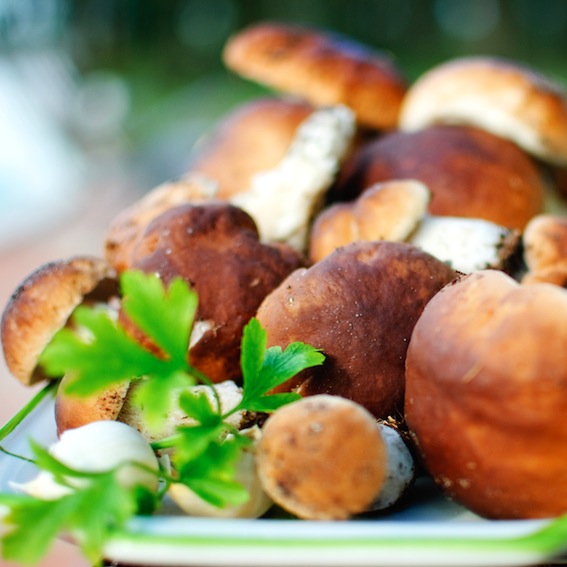-
Yvette’s choux fritters and the French ‘paradox’
Yvette is our nearest neighbour; a traditional Landaise farmer’s wife and testament to the so-called French ‘paradox’* (the Gascons consume more fat than anywhere else in the world, but have one of the longest life expectancies). Almost everything she eats she has either grown or nutured herself and she has no qualms about cutting off a chicken’s head to make her Sunday roast (unlike yours truly wimply here 😉 ) What’s even more amazing is that she’s still speaking to us, despite being woken up on a fairly regular basis by the thundering of our escaped horses’ hooves, churning up her land.
These little delicacies are light, airy, crisp and moreish – or so I’m told – this version contains wheat flour so I can’t eat them, but I shall be trying out a wheat-free version soon.
Ingredients (makes about 20 fritters)
125 ml cold water
50g butter, cut into small cubes
100g self-raising flour
Pinch of salt
2 teaspoons of vanilla essence
1 tablespoon of sugar
2 eggs
1 tablespoon of rum
1 litre of vegetable oil (grapeseed)
Sugar for decoration
Put the cold water in a medium-sized saucepan together with the butter, sugar, vanilla and salt. Place the saucepan over a moderate heat and stir with a wooden spoon until the butter has melted and the mixture comes up to the boil. Remove from the heat immediately and throw in the flour, whisking well until you obtain a smooth ball of paste that leaves the sides of the saucepan clean (this will probably take about a minute).
Next beat the eggs well, then add them into the mixture, little by little, mixing well. Beat until you have a smooth glossy paste, which you should then leave to cool for about 30 minutes.
Just before cooking, add the rum to the paste and heat a litre of grapeseed oil to 180°C. Cook tablespoon-size balls of paste until they flip themselves in the oil and are golden-brown all over. Toss in the sugar and serve hot or cold.
* I put the word paradox in inverted commas because I don’t believe it to be a paradox at all. It became known as such simply because it went against the grain when trying to prove a link between high-fat consumption, cholesterol and heart disease. See here.
-
Endives and ham ‘au gratin’ and cantankerous journalists
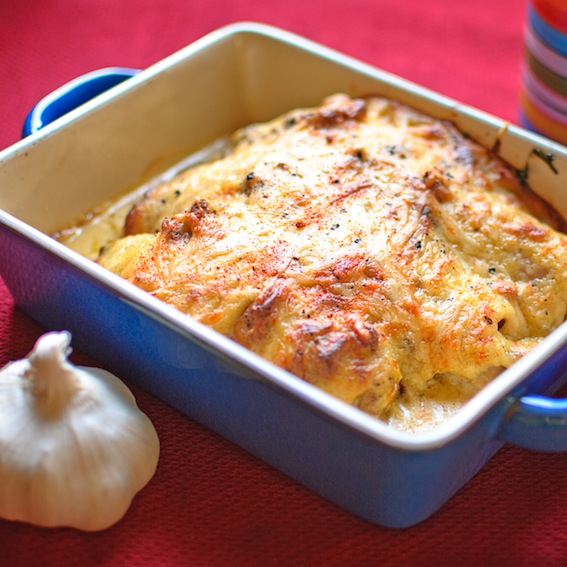
I keep reading articles in the English-speaking press about how miserable the French are at the moment and that morale has never been lower. I can’t help feeling that this is no more than a bit of misguided wishful-thinking on the part of ill-humoured hacks (I’m talking about you, Toby Young), but let me nonetheless reassure everyone that however down-at-mouth the French are, they still know how to eat…
This is a deliciously light and good-humoured dish to serve with a side salad and a wide grin 🙂
Ingredients (serves 4)
8 endives
8 slices ham
200g of grated hard cheese (I use Comté, but you could use Cheddar or Gruyère…)
For the gluten-free béchamel sauce :
30g chickpea flour
15g butter
2 tablespoons’ olive oil
250ml milk
200ml vegetable stock
1 tablespoon mustard
Seasoning to taste: sea salt, black pepper, nutmeg
Boil or steam the endives until cooked (about 15 minutes in salted boiling water or 8 minutes in a steamer). Preheat the oven to 220°C. Once cooked, drain well and try to press out any remaining water. Wrap each endive in a slice of ham and lay in a baking dish.
To make the béchamel sauce, melt the butter and heat the olive oil in a saucepan. Add the flour to the butter/oil mixture and stir rapidly with a whisk until you obtain a mousse-like mixture. Add the liquid (stock and milk) little by little, whisking vigourously to avoid lumpiness. Keep whisking and adding liquid over a gentle heat until there is none left and the sauce thickens slightly – you are aiming for a smooth, glossy, creamy pouring sauce. Add the mustard and the seasoning and leave to heat for a further five minutes over a very low heat, whisking from time-to-time.
Pour the sauce over the ham-wrapped endives and add the grated cheese. Bake for about 20 minutes until bubbling and golden-brown. -
Ceps in the country (and unhinged Frenchmen)
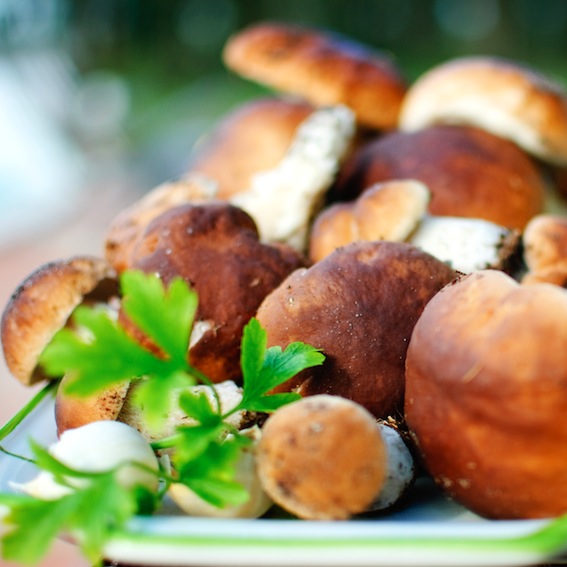
When it comes to mushrooms, the French become homicidal maniacs. Though only when it comes to mushrooms, of course 😉 My husband is a case in point. Last year, before he’d got ‘into’ mushrooms and ceps (also called king bolete or porcini) in particular, he announced that anyone mushrooming on our land was more than welcome to keep whatever they found. Our land was there for everyone – for the greater good, blah, blah, blah. Well not anymore. No siree.
The greater good pitch vanished the moment we discovered how best to cook and savour them. We now have tacky signs up everywhere saying, roughly translated, ‘Cep bugulars get out!’, ‘Steal our ceps at your own peril!’, ‘Beware! ferocious cep-guarding dog’… During The Season, he gets up at the crack ofmushroomdawn and skulks out into the half-light, a rifle over his shoulder. OK, I’m making the rifle bit up, but he definitely would if he owned one.
Mocking aside, ceps really are worth it; they have a deep, earthy, woody taste and are rich in vitamins A and C, iron, potassium and selenium. They can mostly be found in the early Autumn under mature trees such as spruce, pine, hemlock, birch and oak. Just don’t come looking for them on our land 😉

Ceps fried with garlic and parsley
Ingredients :
Fresh ceps
Olive oil
Butter
Garlic, chopped
Rock salt
Freshly ground black pepper
Fresh parsley, chopped
Any earth or sand clinging to the ceps should be brushed off gently with soft-bristle brush. Avoid rincing in water if possible. They should then be cut with a very sharp knife (to avoid bruising) into half centimetre slices. Heat the olive oil and butter in a frying pan – there should be enough oil to coat the bottom of the pan easily. Once the oil is hot (but not smoking), add the ceps. Cook for seven minutes on each side – the white flesh should become golden brown. Add the chopped garlic and parsley two minutes before the end of cooking.
In my opinion, the best way to eat ceps prepared in this way is on their own or perhaps with a plain omelette. They go nicely with green salad and some crusty French bread. -
Cassoulet and mouthfuls of sand

My annual flirtation with vegetarianism will have lasted almost a month. Hugo, our labrador, is having a whale of a time ‘playing’ with pheasants at the moment. He waits until I’m in the saddle, then goes out in front to lift a pheasant as close to the horse’s nose as possible. This makes my horse spook flamboyantly (Iberian horses are total show-offs and exceedingly supple to boot) and I end up, more often than not, with my nose in the sand. Which brings me back to why I’ve surmised that hunting isn’t all bad; I’m anxious for them to hurry up and butcher a few of the pheasants near us, to give myself a fighting chance at staying in the saddle 😉
This cassoulet is, perhaps for some people, slightly unorthodox in that it has no breadcrumbs on top. In any case, it’s well worthy of a break from half-hearted vegetarianism and is the epitome of ‘real’ food.
Ingredients (serves 8)
1 large onion, sliced
1 red pepper
4 chilli peppers
1 tablespoon olive oil
8 mushrooms
4 medium-sized carrots, peeled and cut into large pieces
5 cloves of garlic, crushed
8 Toulouse sausages
300g salted pork breast
4 pieces of duck confit
2 sprigs of rosemary
2 glasses of dry white wine
5 medium tomatoes, blanched and skinned
500g white haricot beans (these should be soaked overnight if dry)
Seasoning to taste (seasalt, black pepper, Espelette pepper or paprika)
1 teaspoon juniper berries
Start by de-fatting the duck confit in a pan, heating and removing the fat gradually. Put the onions, garlic and olive oil into a large casserole dish and gently brown. Add the mushrooms, carrots, red pepper, chilli peppers and tomatoes and continue to brown on a low heat. Add the sausages, duck and pork and continue to cook for a couple of minutes. Add the white wine, juniper berries and rosemary and bring back to a simmer. Lastly, add the white beans and season well. You will need to add some water – probably about 500ml – enough to come about half the way up the casserole dish. Cook on a lowish heat (140°C) for about two and a half hours, checking from time-to-time that there is sufficient liquid.
This is a very rich dish and should just be served with a crisp green salad. -
Low-GI chocolate mousse with cocoa nibs
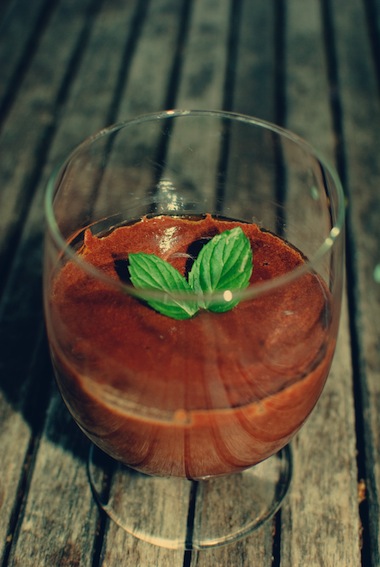
I needed a delicious dessert to make for a lunch party today and, as our kitchen has apparently recently been transformed from family kitchen to medium-scale fig jam processing plant (see previous post!), it had to be something quick and easy. My husband and I married for better or for worse, but absolutely NOT to be cooking in the kitchen at the same time.
This mousse is really divine. It’s rich but simple and not too sweet. The recipe is a slightly adapted (I’m incapable of leaving a recipe intact) Montignac recipe, so its GI rating is good (ie low!) because it contains absolutely no added sugar. The rum I used is very luxurious and deliciously fragrant but I’m sure any rum will do.
Dark chocolate is full of antioxidants. Cocoa is a good source of vitamins and minerals including magnesium, calcium, iron, sulphur and manganese. It also contains B vitamins. Cocoa nibs have all the same benefits as chocolate in a purer, more powerful form.
Ingredients (serves 4)
200g dark chocolate (minimum 70% cocoa)
4 eggs
1/2 glass of rum (5 cl)
2 tablespoons cocoa nibs
pinch of salt
Break the chocolate into pieces and melt in a casserole with the rum. Separate the eggs and beat the whites with a pinch of salt until stiff. Once the chocolate has melted, add the beaten egg yolks to the mixture and stir rapidly for about a minute. Stir in the cocoa nibs and then delicately add the mixture to the egg whites, stiring well to obtain a smooth, homogenous texture. Transfer into four ramekins or glasses. Chill for at least five hours before serving. -
Basque Piperade and a disoriented white hen

When is an a tomato not a tomato? Answer: when it’s an egg…
The white hen has taken to laying her eggs amongst our tomato plants. I only realised the other day when I spotted several egg-coloured tomatoes. As hens tend to lay where there are, or have been, other eggs, I wondered whether she thought that the pepper tomatoes were green eggs. Which begs the question: are hens colour blind or just a few French fries short of a Happy Meal? Answers on a postcard please!
Of course the other explantion is that she’s a Basque hen gagging for some Piperade, no doubt one of the most renown Basque dishes.
Ingredients (serves four)
6 medium tomatoes
2 tablespoons olive oil
100g sliced Bayonne ham
3 cloves of garlic
2 onions
Chopped parsley, thyme, bay leaf
2 red bell peppers cut into strips
2 green bell peppers
2 teaspoons Espelette pepper (if you don’t have this, Paprika, chilli powder or Cayenne will do)
4 eggs
Blanche and skin the tomatoes. Add a tablespoon of olive oil to a medium frying pan and cook the ham until golden brown (about 7 minutes). Set aside. Cook the garlic and onion in two tablespoons of olive oil until golden brown. Add the herbs and peppers, Espelette pepper and seasalt to taste. Cover and leave to cook until the peppers soften (about 10 minutes). Stir in the tomatoes and browned ham and cook until the mixtures melds and juices slightly thicken. Beat the eggs and add over the heat to the tomato/pepper mixture, stirring until cooked. Serve immediately! -
Ossau Iraty and black cherry chutney

I haven’t started talking in tongues; this is the name of a delicious cheese from the Basque region. So delicious, in fact, that it was named ‘Best Cheese in the World’ at the World Cheese Awards 2011. It is nicest served at room temperature with black cherry chutney.
I last enjoyed it just the other day, at the top of a mountain in 30 degree heat, surrounded by 30 ten-year-olds. And it was delicious nonetheless 😉 ! We were on a school trip to the pyrenees, a somewhat long but very enjoyable day. Well, apart from the bit where the coach had to reverse down a tiny mountain road, negociating no fewer than EIGHT hairpin bends backwards. I’m not that cool on tiny mountain roads in a car going forwards, so I’ll leave it to you to imagine the state I was in after this little escapade. There’s always a plus side though, and in this case it was that the children were actually SILENT for the time of the manoeuvre. They also derived much amusement from the fact that their teacher inadvertently let slip a four-letter word (or French equivalent thereof) in sheer terror.
As you can see, I didn’t take a photo of the cheese and chutney. But I did take one of a ‘typical Frenchman going for a picnic in the mountains’!
To make the black cherry chutney:
Ingredients
300g black cherries
1cm fresh grated ginger
Pinch of cinnamon
Black pepper
60g of cane sugar
2 tbls white vinegar
Heat the cherries and sugar in a casserole for just under five minutes. Add the ginger, cinnamon and black pepper and continue to heat for another five minutes. Add the vinegar and cook until the mixture starts to congeal. Leave to cool before serving. -
Navarin of chicken

I know that, strictly speaking, this should be navarin of lamb. I did briefly hover over the lamb counter, but before I’m ever able to pass from hover to purchase so many images of sweet, fluffy new-born lambs dancing in the long spring grass come to mind that I just can’t do it. Mind you, now that we have hens and I see them living their free-range lives, chicken will no doubt be off the menu soon too!
From an idealistic perspective I should probably be a vegetarian, but I remain entrenched in my conviction that we are meant to eat at least a small amount of meat. I’ve also seen too many miserable-looking vegetarians for it to be an attractive proposition; why is it that they so often look grey and dour?
The term ‘navarin’ is really a reference to the vegetable content of the dish and not the meat, so here is my Navarin for Sensitives Souls:
Ingredients (serves 4)
4 chicken wings and 4 legs
4 spring onions
10 baby carrots
4 baby leaks
6 new potatoes
4 baby turnips
1 courgette
cup of peas
olive oil
seasoning (salt, pepper, chicken stock)
bay leaf, rosemary, fresh mint
2 glasses of dry white wine
Slice the onions and gently brown in a casserole dish in the olive oil. Add the chicken pieces and seasoning and brown gently for a couple of minutes. Add the wine, chicken stock and herbs. Bring to a gentle simmer and add the carrots, leaks, turnips and potatoes. Place in a preheated oven (180°C) for an hour and then add the peas and sliced courgettes, making sure that the liquid level in the dish is still at least 3cms. Cook for a further 20 minutes and add the fresh chopped mint just before serving. -
Almond chocolate cake
You may have noticed that I never use normal flour in my recipes. This isn’t only because eating refined wheat flour is about as nutritious as snacking on yesterday’s newspaper, but because I’m wheat-intolerant. It’s not something I harp on about a) because it’s boring and b) because I’ve noticed that not ‘tolerating’ is something that brings out the devil in a lot of people. I’ve lost count of the number of times people have offered me something that is quite patently going to have me doubled up in agony within the next twelve hours and refused to take no for an answer when I decline: ‘Oh go on, I’ve just made it, a little bit won’t hurt, surely…’ It’s as if I’m saying no to be awkward, or to be interesting or different. Err no, if I wanted to be awkward I’d ask you to serve it to me sprinkled with powdered rhino horn, and if I wanted to be interesting or different I’d dye my hair indigo and take up mud pit belly flopping.
This cake, regardless of your ‘wheat status’, is divine. It will leave you wondering why you ever made chocolate cakes with wheat flour. The fact that it uses powdered almonds means that, for a chocolate cake, its GI is quite low and that it contains valuable nutrients. It also has a fairly low sugar content.
Ingredients
5 eggs
130g cane sugar
140g powdered almonds
60g butter
60g coconut oil
125g dark chocolate (preferably 90% coco)
pinch of bicarbonate of soda
1 tsp baking powder
Preheat the oven to 150°C. Melt the chocolate with the butter and coconut oil. Once melted, add to the sugar, egg yolks, almonds, bicarbonate of soda and baking powder. Whisk the egg whites until stiff. Fold the egg whites into the chocolate mixture and pour into a 20cm cake tin. Bake for 45 minutes.
-
Chicken in the pot
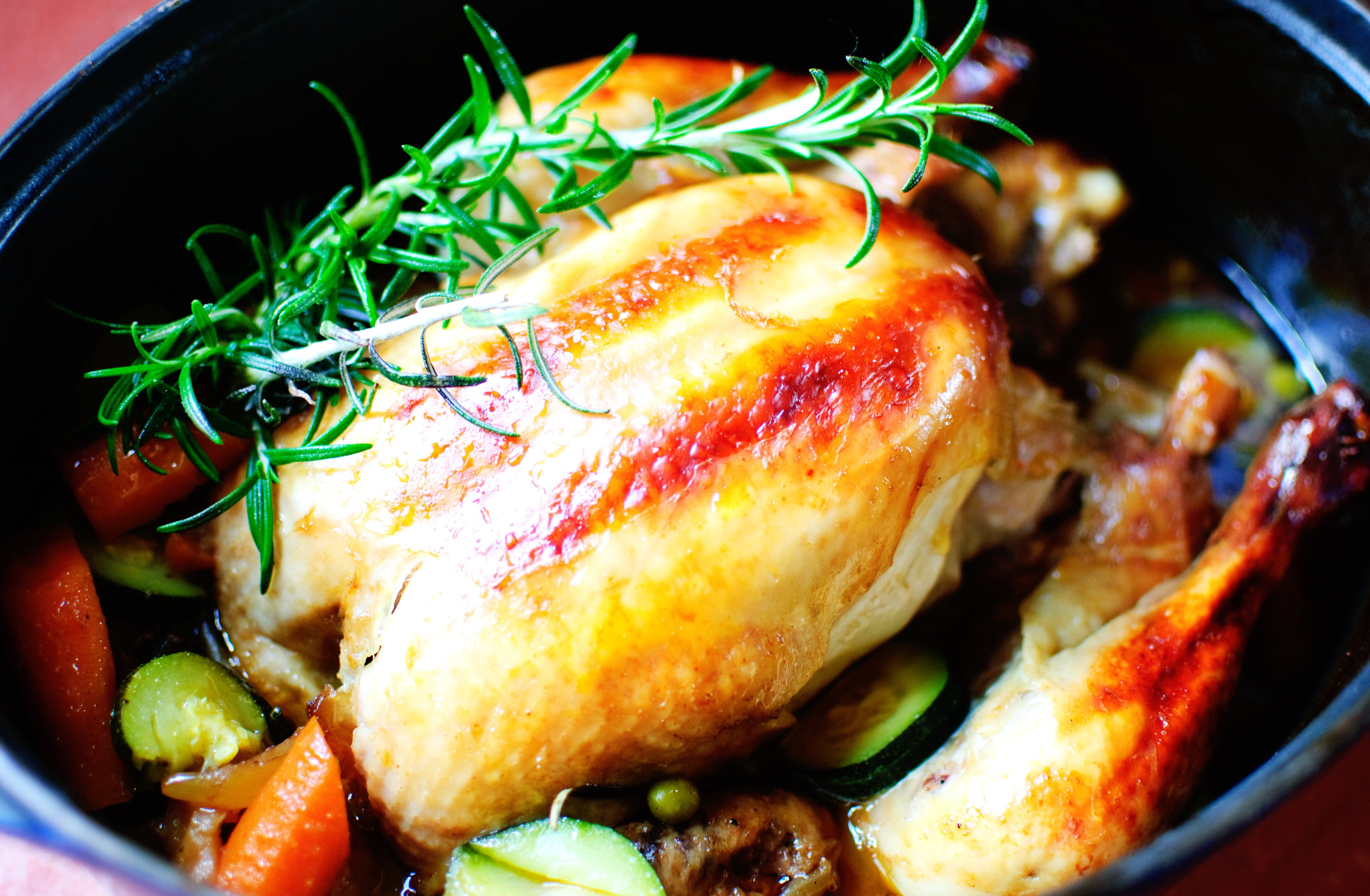
This dish is traditional Sunday fare in Aquitaine. It was made popular by Henri IV who declared his hope to be that France would become peaceful and prosperous enough for every family to be able to enjoy ‘poule au pot’ every Sunday. This is obviously my ‘take’ on the dish; I don’t think that French families had access to Lee and Perrins sauce in Henri IV’s day.
Today is election day. Here’s to hoping that our next president will bear Henri’s good intentions for peace and prosperity in mind…
Ingredients (serves 6)
1 chicken
1 onion
1 leek
3 cloves of garlic
3 medium carrots
1 cup of peas
5 mushrooms (sliced)
1 courgette
rosemary, bayleaf
olive oil
glass of white wine
Lee and Perrins sauce
2 tablespoons of redcurrant jelly
seasoning to taste (sea salt, pepper and paprika)
Lightly brown the onion, garlic and mushrooms in the olive oil in a casserole dish. Add the chicken and brown on both sides. Add a good slug of Lee and Perrins and the redcurrant jelly and continue heating. Add the sliced carrots, rosemary and bayleaf and turn chicken right-side-up. Season generously and add the glass of white wine. If you don’t have any wine open, you can use apple juice for a sweeter taste, or just water with a tiny bit of chicken stock.
Put the lid on the casserole and cook in a medium oven (150°C) for about an hour and a half. You should check half way through that there is still some liquid left in the bottom of the casserole (a couple of centimetres is ideal). If there is too much liquid you could take the lid off for the last 15 minutes. The peas and sliced courgettes should be added about 20 minutes before serving so that they stay firm.
This is lovely served with mashed potato any green vegetable.

